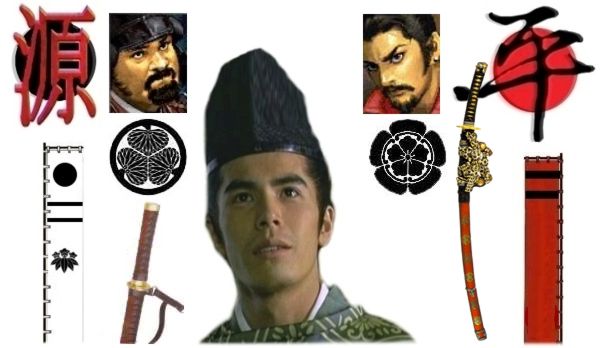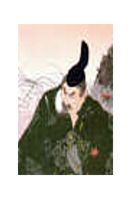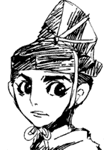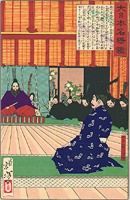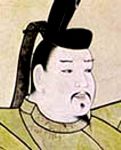THE
SWORDS, PENS & POLITIX OF THE JAPANESE
CLANS OF |
Picture caption: Lord Minamoto Hiromasa in Takita Yojiro's movie Onmyoji, Shogun Tokugawa Ieyasu (upper left), descendant of the Minamoto clan, and real-life warlord Oda Nobunaga (upper right), whose line of ancestors started with the Taira clan. Click here for story and pictures of the real-life Minamoto Hiromasa, Abe Seimei, and Heian lifestyle that the movie is set in. |
| WHY
MINAMOTO & TAIRA? --------------- KYOTO,
749
Let's start from the very brass tack. The word 'samurai' was invented during the languid period of the history of Japan, stretched between the year 749 and 1185, that is portrayed in Takita Yojiro's movie Onmyoji, i.e. the Heian era (click here for everything about the Heian lifestyle). Before this era, the men we now refer to as 'samurai' were called 'bushi'. This word meant 'man of the bow' -- AKA 'the archer'. That's why samuraihood is not inseparable from swords and swordsmanship, as the Tokugawa shogunate implanted in your mind later (click here for the original samuraihood). It was the Tokugawas, too, that infused the older word 'bushi' with inflated values until it came to you as 'bushido' (click here for the truth about Bushido). 'Samurai' was a derivation from the term 'sabu-rau', which meant, at the time, 'someone in service' -- the latter referred to anybody with the Imperial blood in his veins, so it included Princes and courtiers. All of those were civilians. So the man 'in service' was someone very much attached to weapons, since weapons are of course no civilian toy. Gradually, after a few years, the word 'sabu-rau' slid down into 'samurai' when spoken, and this finally found its way into the written vocab and it would stay there for good.
The tradition of using family or clan crests started with the Minamoto and Taira clans of the Heian era, too (the Fujiwaras had seen the use of family crests -- the one they used was similar with the Minamoto crest -- but putting crests on everything wasn't a universal practice yet in their times), and it developed into fixity in the next thousand years. By the year 2000, there have been more than 6,000 family crests in Japan, not to mention corporate logos. Click here for pictures & history of the family crests of Japanese samurai clans.
The all-powerful Fujiwara clan (click here for lists of Fujiwara clansmen and women) was a crowd of sedentary mammals -- they were much more of bureaucrats than warriors. When they lost the grip, Japan was changed for good. The Tairas were a warlike bunch. The Minamoto clan that reign after them was even more than that: they were virtually the ones who founded all the basix of samuraihood. It was the Minamoto clan, the origin of the characteristically samuraist tradition of honorable suicide ('seppuku' in Japanese). It started with the suicide of Minamoto Yorimasa in 1180 (click here for story and pictures). Minamoto Yorimasa did it after losing the war against the Taira clan. After that, 'seppuku' became inseparable from the samurai code of honor. The last most-famous act of 'seppuku' was sort of recent: novelist Mishima Yukio (real name: Hiraoka Kimitake, b. 1925) did it on November 25, 1970. Mishima's scary grandma was a Matsudaira, and among his closest friends was an inconspicuous man with a heavyweight name: Tokugawa Yoshiyasu. Click here for all the story and pictures of Mishima's Bushido, and the Shield Society. Another mark of the samurai, the distinct hairdo that left the forehead clean-shaven, began to spread during the reign of Shogun Ashikaga Takauji (1305-1358). The style that initially was just a practical way to keep the hair from falling over the eyes in battle gradually got adopted by virtually all sociopolitical classes, differing from true-blue warriors' only in the way the knot of the hair at the back was done. This withered into a mere habit when Japan was ruled by the fifth Tokugawa Shogun. Since 18th century, people who belonged to the warrior-class were all idle samurai -- none of them had ever been in battle all their lives. The hairdo, the dress, and the samurai class itself, were all abolished when Emperor Mutsuhito (Meiji) took control of Japan in 1868. Only the clan crests stay on -- though not exclusively for the samurai class anymore. Click the following names for the REAL last samurai : Lord Saigo Takamori of Kagoshima and the Shinsengumi of Kyoto. Reality check Real life in Minamoto & Taira clans' era. - Japanese sociopolitical ranks 1185 - 1868. - Japanese Emperors, Empresses, Shoguns, Regents, Chief Ministers, Rulers since 660 B.C. until today - Samurai are identical with swords, right? WRONG. - Many important traditions that we think of as Japanese are actually imported from China. - Japanese beliefs and philosophy that made the backbone of the warrior class. - Why did the rest of Japan accepted the hegemony of the samurai class? - Do you really think that you have known everything about the Bushido? What if I say I don't think so? Check this out. |
THE
ERA OF GREAT CLANS
--------------- KYOTO, 800
So, the name Minamoto (a.k.a 'Genji', in Chinese) that Ito Hideaki's character in Onmyoji is called by is not just another name in Japan. It is nearly the most famous, oldest and unerringly associated with 'bushido' or the way of the samurai. Historical sources are abundant, the most well-known of which is the classic Japanese reading Tales of the Heike (Heike Monogatari), although the title clearly shows it tells of the Minamoto's arch-enemy's stories, the Taira clan (a.k.a 'Heike' in Chinese). The Minamoto clan, whose name means 'original town', was founded by Tsunemoto, grandson of Emperor Seiwa (859-880) and son of the Minister of War. Their original homebase was around Osaka. The clan's banners are black-and-white. The Taira (which means 'great folks') clan, whose banners are black-and-red, was founded by Takamochi, Lord Chamberlain of the Imperial Court, who could claim that the DNA of one of the most famous Emperors of Japan, Kuammu (782-805), reigning in his times, to be his, too. This clan's original whereabout was not very far from Kyoto. Both clans rose when the civil service, backbone of a bureaucratic country, was almost totally dominated by the Fujiwara clan (this name means simply 'wisteria flowers of the swamp', and instantly corresponded visually with their crest -- if you have never ever seen a wisteria before, click here for pictures). They got there after getting rid of the one and only rival clan, Sugawara (see the Shinto pages for pictures and story of the greatest of the Sugawaras who has been, until this very day, a god to the Japanese). The Fujiwaras, bound by their jobs, had their HQ wherever the Emperor was. So there was no job around the Imperial House for anybody who wasn't a Fujiwara. Naturally the Tairas and Minamotos took to the military ground because of their temper and talent; despised (unspokenly) by the so-called noblepersons of the era, they snatched the only job available -- as men of war. Both clans served the Emperor well in this, and for some time their reps co-existed peacefully in the capital city Kyoto (Onmyoji's Heian-kyo), and both were in a shared constant tension against the Fujiwaras.
The Minamotos have been famous archers, even (according to legends) a chimera couldn't defend itself against their state-of-the-art archery. Minamoto Yorimasa was especially given this credit (click here for story and pictures). The Taira didn't do any worse; if they met during an outdoor martial art practice the score was more or less even. Yet, those armed-to-the-teeth clans didn't rise at once to depose the all-and-everything Fujiwara people; while ousting the reigning monarch was (as has been) unthinkable. Only in 10th century happened something anomalous to the history of Japan of all times: someone came out to claim the throne, i.e. to be an alternative Emperor. It never happened before and since; all the warlords of the 16th-century vied for power and yet they always revered the Emperor of the realm of the time. This man was Taira Masakado. He was darn serious about it; he built an exact copy of the original Imperial Palace of Kyoto, his tailors made imitations of the imperial robes, his vassals practiced the imperial etiquettes, and so on. But he lost the war against the so-called true proprietor of the mandate from heaven, because this authentic Emperor got the warlords rallying for him while Masakado was virtually alone. After his violent demise in the hands of Fujiwara Hidesato in the infamous battle of Kojima, Hitachi, he was deified in today's Tokyo because people believed that his soul was still extant and very angry at everybody. This fear of Masakado's wrath persists even today; and he was usually nailed down as the one causing the great 1920's earthquake in Tokyo. However, no other Taira ever repeated the Masakado experiment again. But descendants of Taira Masakado survived until the end of the Tokugawa regime; the clan descended from this political adventurer was the Soma of Mutsu province. Fujiwara Hidesato, the man who crushed Taira Masakado's rebellion, would see his DNA carried down into the next centuries by several immortal warlords such as the Hatano clan of Tamba and Gamo clan of Omi -- the latter was to be Oda Nobunaga's in-law, because his daughter Oda Fumeko married Gamo Ujisato, one of the best Captains in the Oda army (click here for story and pictures).
Taira
Masakado wanted to be Emperor; after more than 1,000 years he's still
mad at the Tokyoites for rejecting the claim.
That's why they keep on delivering the offerings to his tomb among the skyscrappers even in 2005. The last pic shows Masakado's nemesis, Fujiwara Hidesato, when getting the mandate to quench the rebellion from the Emperor. This Taira experiment has been a favorite subject for moviemakers, comic book writers and animators since 1920's.
THE IMMORTAL MINAMOTO BROTHERS OF KAMAKURA, 1185
In 1156, the Minamoto and Taira clans of warriors fell out of love for each other and thence became implacable enemies. This was a historical necessity, since on your planet it's always impossible that two equally warlike crowds with equal strength live peacefully and meekly around the same block -- so it didn't need a tsunami to start the bodycount. Japan only needed two men, in fact, to start this first Minamoto versus Taira war. Both of which were accidentally Emperors -- at the same time (click here for story and pictures). Though the Fujiwaras backed-up the Minamotos, the Taira won. The head of the clan, Taira Kiyomori (1118-1181), reset the civil service and everything else around his Emperor, while systematically eradicating each and every Minamoto he could lay his hands on. Minamoto Yoshitomo (1123-1160), head of the clan, who led the war with Fujiwara Nobuyori, was murdered by his own valet bribed by the Taira (click here for pictures). All of Yoshitomo's kids were assassinated. Only three survived, being on the run, and these were the most famous Minamoto samurai ever -- Minamoto Yoritomo (1147-1199) plus his younger brothers Minamoto Noriyori (1156-1193), and Minamoto Yoshitsune (1159-1189, the year of death is nothing but a speculation). After laying low for what seemed to be eternity, the Minamoto bros could exhale when Taira Kiyomori died an incongruently domestic death at last. Even for a medieval Japanese warrior, Kiyomori's death-wish was especially horrific. He told his sons and Generals that he wanted no lavish funeral or a tomb in all shogunal splendor; all he wanted was the severed head of Minamoto Yoritomo put on a spike right in front of his grave (click here for pictures of Taira Kiyomori and his clansmen). In 1185, the Minamoto brothers and their vassals rose up against the Taira. In numbers, they were smaller, but as it usually happens with a rising clan they were matchless in battle. The Taira clan was politically wiped out from the face of the planet in the decisive battle of Dan no Ura. The testament of Taira Kiyomori, then, was practiclly impossible to have been carried out. Yoritomo built the Minamoto stronghold at the beautiful coastal spot Kamakura, that thrived since 1184, himself was created the Shogun by the Emperor in 1192. Until he died a natural death in 1199, Minamoto Yoritomo had been a ruling General of Japan and quite a good one, except for one thing: his paranoia that gave the Japanese history its most infamous fratricide ever. Minamoto Yoshitsune was a soldier, period. He had no lust for political power, and was happiest at war. But his prowess had always been his older brother's nightmare since the last battle against the Taira, and Yoritomo finally did what he had driven himself to: he banished Yoshitsune and got him assassinated at last. But the obscure archiving around his death gave Japan its greatest samurai in history. Minamoto Yoshitsune has from then on been immortal as one heck of a paragon of chivalry, honesty, and courage, down to this very day. Legends have it that instead of death by his own treacherous and envious brother, Yoshitsune fled to China and became.....the Mongols' own Genghis Khan (click here to see pictures of Minamoto Yoshitsune).
THE
TAIRA - MINAMOTO ALLIANCE
OF 16TH CENTURY
The Taira clan's descendants were only a thumbnail compared to the number of Minamoto and Fujiwara branches; the most well-known of them were the Ashina clan of Aizu, Hojo, Hatakeyama of Noto, Soma of Mutsu, Shibata and Oda clan of Owari. Of these, Oda Nobunaga, the Lord of Owari, was the best Taira-blooded person ever. The Oda clan started from the great-grandson of Taira Kiyomori, named Chikazane. The kid was orphaned very early in life because his dad Taira Sukemori was mandatorily killed by the Minamotos during the nationwide retaliation campaign. Tradition has it that Taira Chikazane was given by his mom, who escaped the inevitable 'clan-cleansing', to a Shinto priest of the village of Oda (or 'Ota'; that doesn't really make any difference since the Japanese way to say 'd' is just a nanosecond away from 't'). Chikazane deleted the clan's name from his own for security reasons, got himself a new line of priests using the name of the place as the clan name. Oda Chikazane's family tree would in time yielded Oda Nobunaga, and a branch of the same line gave birth to Lord Shibata Katsuie of Echizen (today's Fukui), Nobunaga's General and brother in-law. In the decades of Oda Tsunematsu and Oda Tsunetake (right around 1400), the head of the clan was an officer in Owari (a part of Aichi Prefecture today). The Odas, being a rather insignificantly small crowd, used to be vassals of the Shiba clan from Echizen (click here for the complete family tree of the Oda clan). Clickables The village of Ota, birthplace of the Oda CLAN - All that you could possibly know about Oda Nobunaga
After Oda Nobunaga's and Toyotomi Hideyoshi's reigns were over, before taking up control over Japan Tokugawa Ieyasu had to quench a clan which was known to historians as 'the latter Hojos' of Odawara, another compound of warriors of Taira descendants. Of the Minamotos, it is Oda's ally Tokugawa Ieyasu, the Lord of Mikawa (also a part of Aichi today), that has been the greatest ruler of the clan (he got documents to prove this pedigree, but some still disbelieve it even today because in the Tokugawa era there was also a stack of archives saying that the clan descended from the Fujiwaras).
CLICK THE PIX FOR MOVIE SCENES
Anyway, Ieyasu usually signed official documents as 'Minamoto no Ieyasu', or 'Lord Ieyasu from the House of Minamoto' -- in a feudal society like Japan in his time onward, it surely mattered that one comes from the Emperor's own family line, as the Tokugawas, inheriting the DNA from the Minamotos, were. That means Ieyasu was not just any warlord -- it served to legitimize his clan's rule upon Japan afterwards. The name 'Tokugawa' was taken by Ieyasu's ancestors, just like the Odas', from a dot on the medieval Japanese map. Tokugawa Ieyasu's daddy came from a place named 'Matsudaira'; it was Ieyasu's original clan-name. Other clans that shared the Minamoto DNA were actually as famous as Tokugawa, only they never stayed as long in history as the Tokugawas were. The Awaya clan of Aki, Nitta of Shimotsuke, Horiuchi of Kii, Imagawa of Suruga, Ashikaga of Shimotsuke (all those Shoguns), Ishikawa of Mikawa, Takeda of Kai, and Ikeda of Owari -- one of the women of which was Oda Nobunaga's concubine. Clickables Nitta Yoshisada, an immortal paragon of chivalry - Imagawa Yoshimoto, daydreaming warlord of Suruga and the one who kept Tokugawa Ieyasu as hostage for 10 years - Takeda Shingen, the darn unlucky mighty warlord of Kai mountains - Ikeda Mikoto, mother of the most lamentable kid of Oda Nobunaga's - Matsudaira Nobutsuna, advisor to Shogun Tokugawa Iemitsu who crucified Christians and closed Japan up behind iron curtain for 200 years - Matsudaira Katamori, the shady boss of the Tokugawa organized assassins, Shinsengumi. Both Oda Nobunaga of the Taira and Tokugawa Ieyasu of the Minamoto are accidentally warlords of the same era in 16th-century, and as inseparable from each other as their ancestors have been, in any storytelling since.
Kamakura
in 2005 -- a beautifully tranquil shoreline that once played hostess
to the mighty Minamoto
clan in 1184
THE PING-PONG OF CLANSMEN'S POWER OVER JAPAN
The Minamoto Shoguns (those using exactly that name) were Yoritomo (1185-1199), Yoriiye (1201-1203), and Sanetomo (1203-1219). After that, the Fujiwara came back to the scene thanks to the intrigues of Yoritomo's widow Hojo Masako (the 'Nun Shogun' and her power-hungry daddy Hojo Tokimasa; click here for story and pictures). The Hojo clan sprang out from the genealogical line of Emperor Kuammu (782-805), its forefather is Taira Tadamori (1096-1153). Fujiwara Regents were Yoritsune (1220-1243) and Yoritsugu (1244-1251, he is featured in Onmyoji). Then the Hojo clan that has established itself as the kingmaker put the Emperor's sons into the same imperial shoes: Munetaka (1252-1265), Koreyasu (1266-1289), Hisaakira (1289-1307), and Morikuni (1308-1313). After these nominal regencies came the Ashikaga clan, started from Ashikaga Takauji (1336) down to Ashikaga Yoshiaki (until 1573), and everybody in this clan preferred the more warlike title 'Shogun' to precede their names (click here for the story and pictures of how Ashikaga got the power). Then came Oda Nobunaga of the Taira clan again -- he, contrary to the usual 'Westerners' misreading, was never a Shogun, and didn't care at all that he had no official title to rule Japan with between 1568 and 1582. After an interlude of the happy Toyotomi years (1582-1599), the clan that got the legacy of the Minamotos, Tokugawa (and its branch, Matsudaira), established a shogunate that lasted the longest. It began in 1603 and lasted until 1868. Tokugawa Shoguns were Ieyasu, Hidetada, Iemitsu, Ietsuna, Tsunayoshi, Ienobu, Ietsugu, Yoshimune, Ieshige, Ieharu, Ienori, Ieyoshi, Iesada, Iemochi, and Yoshinobu -- fifteen in all, until a young Emperor got sick of his vassal acting like a supreme ruler of the empire, and his advisors backed him up to regain political power from the last of the Tokugawas. This Emperor was Mutsuhito, or the one we now call Meiji. That ended the ping-pong of powerholding between Minamoto and Taira. As a postscript, I could also add that the Fujiwara clan fathered the greatest number of later clans compared to the Tairas and Minamotos. Warlords that claimed descent from the House of Fujiwara Regents were, among others, Ito clan of Hyuga (Kyushu, Christian warlords), Ayukai of Mutsu, Gamo of Owari, Fuwa of Mino, Honda of Mikawa, Arima of Hizen (Kyushu, also Christian), Hatano of Tamba, Ii of Totomi, and Ikoma of Owari -- the latter was the clan with which the second concubine of Oda Nobunaga's belonged to. Clickables Everything about all Tokugawa Shoguns - The last Tokugawa Shoguns: Iesada, Iemochi, Yoshinobu - Emperor Meiji - The Meiji versus Tokugawa war, 1863-1868 - Ito clan of Kyushu - Arima warlords of Hizen - Honda Heihachi, the best of Tokugawa Generals - Ikoma Kitsuno, mother of Oda Nobunaga's first and best son and heir Oda Nobutada Simply put, focusing on the rivalry between the Taira and Minamoto clans, the feudal Japanese powergame that was played since time immemorial until 1868 produced rulers of Japan in a weird succession like this (upper-capped entries are clickable):
Quickie Click here for the simplest picture of that same political structure.
|
|||||||||||||||||||||||||||||||||||||||||||||||||||||||||||||||||||||||||||||||||
NEXT PAGE:
STORIES & PICTURES OF MINAMOTO
VERSUS TAIRA PART 2: FAMILY
TREES & POETRY,
FUJIWARA CLANSMEN & LADIES, AND OTHER CLANS
OF THE SAME ERA
OR SEE STORY & PICTURES OF THE BEST DESCENDANTS OF:
 |
 |
OR CLICK THE FOLLOWING LINX:
